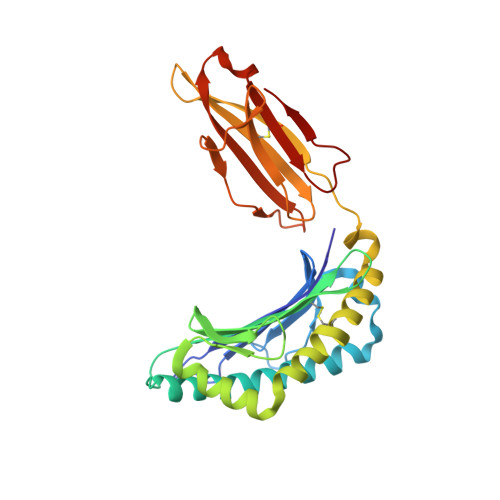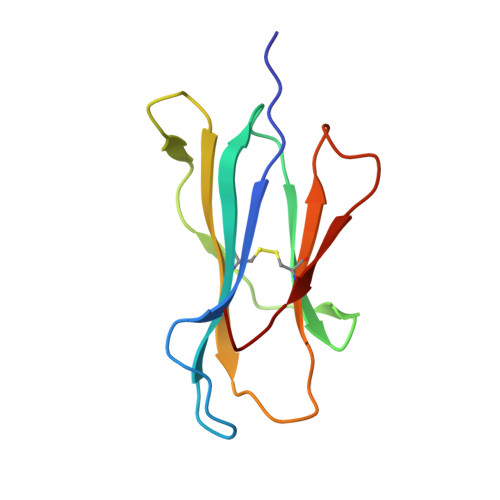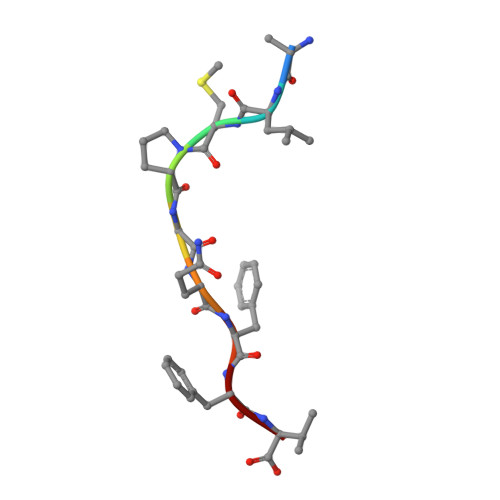Strict Assembly Restriction of Peptides from Rabbit Hemorrhagic Disease Virus Presented by Rabbit Major Histocompatibility Complex Class I Molecule RLA-A1.
Zhang, Q., Liu, K., Yue, C., Zhang, D., Lu, D., Xiao, W., Liu, P., Zhao, Y., Gao, G., Ding, C., Lyu, J., Liu, W.J.(2020) J Virol 94
- PubMed: 32522857
- DOI: https://doi.org/10.1128/JVI.00396-20
- Primary Citation of Related Structures:
6M24, 6M2J, 6M2K - PubMed Abstract:
Rabbits are pivotal domestic animals for both the economy and as an animal model for human diseases. A large number of rabbits have been infected by rabbit hemorrhagic disease virus (RHDV) in natural and artificial pandemics in the past. Differences in presentation of antigenic peptides by polymorphic major histocompatibility complex (MHC) molecules to T-cell receptors (TCR) on T lymphocytes are associated with viral clearance in mammals. Here, we screened and identified a series of peptides derived from RHDV binding to the rabbit MHC class I molecule, RLA-A1. The small, hydrophobic B and F pockets of RLA-A1 capture a peptide motif analogous to that recognized by human class I molecule HLA-A*0201, with more restricted aliphatic anchors at P2 and PΩ positions. Moreover, the rabbit molecule is characterized by an uncommon residue combination of Gly53, Val55, and Glu56, making the 3 10 helix and the loop between the 3 10 and α1 helices closer to the α2 helix. A wider A pocket in RLA-A1 can induce a special conformation of the P1 anchor and may play a pivotal role in peptide assembly and TCR recognition. Our study broadens the knowledge of T-cell immunity in domestic animals and also provides useful insights for vaccine development to prevent infectious diseases in rabbits. IMPORTANCE We screened rabbit MHC class I RLA-A1-restricted peptides from the capsid protein VP60 of rabbit hemorrhagic disease virus (RHDV) and determined the structures of RLA-A1 complexed with three peptides, VP60-1, VP60-2, and VP60-10. From the structures, we found that the peptide binding motifs of RLA-A1 are extremely constraining. Thus, there is a generally restricted peptide selection for RLA-A1 compared to that for human HLA-A*0201. In addition, uncommon residues Gly53, Val55, and Glu56 of RLA-A1 are located between the 3 10 helix and α1 helix, which makes the steric position of the 3 10 helix in RLA-A1 much closer to the α2 helix than that found in other mammalian MHC class I molecules. This special conformation between the 3 10 helix and α1 helix plays a pivotal role in rabbit MHC class I assembly. Our results provide new insights into MHC class I molecule assembly and peptide presentation of domestic mammals. Furthermore, these data also broaden our knowledge on T-cell immunity in rabbits and may also provide useful information for vaccine development to prevent infectious diseases in rabbits.
Organizational Affiliation:
School of Laboratory Medicine and Life Sciences, Wenzhou Medical University, Wenzhou, China.
















